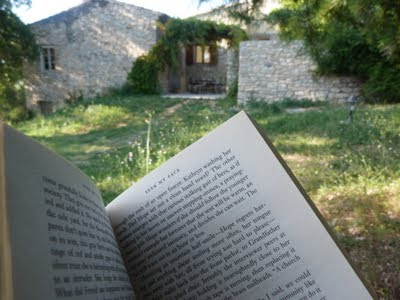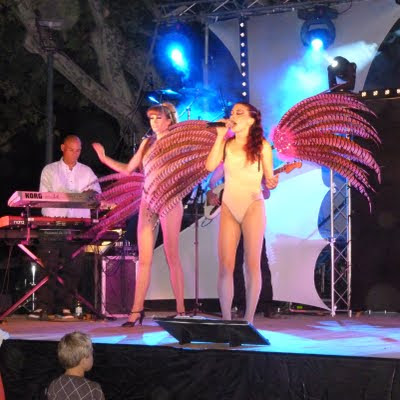Yet another of life’s mysterious circles. My life always seems to abound in connections and coincidences, and here is the latest. My New York publishers (rather rashly) sent a review copy of The Lantern to the eminent author, art historian and literary critic Mary Ann Caws, who is currently Distinguished Professor of English, French and Comparative Literature at the Graduate School of City University in New York.
Well, not only did she like it, but I am honoured and delighted that she wrote the following review which generously highlights points of comparison between her work as a translator and summer life in Provence, and Eve’s story in the novel. She also asked me a few questions, and posted the interview on her blog, New York, Provence, Poetry (click here).
It turns out that she too knows the artist Julian Merrow-Smith, whose marvellous, luminous paintings have often adorned these pages, and his wife Ruth Phillips, the ‘cellist and writer. So, as I never need much excuse to include a Merrow-Smith picture and direct you to his Shifting Light daily painting blog (click here), the illustrations on this post are from his recent archive: High Lavender and Lavender Field in the Drôme.
Here is Mary Ann’s review:
"I have just finished an advance copy of Deborah Lawrenson's The Lantern, about the Luberon and Cassis, near me in my summers and both etched in my mind and writings -- and the too-good-to-be-trueness of a relationship -- and essentially about the haunting of a place and a self by a memory, or several. Living my summers, as I do, in a It Had To Be Fixed house, that is, my cabanon that has seen 300 years of life, and death, and horses and peasants and, now, us, every page spoke to me of much. The descriptions are, each one, themselves a haunting -- the smell of lavender and of almond biscuits, the taste of the various winds in their howling and their gentleness, the sight of the squirrel-like loirs or dormice scuttling about and dislodging the tiles on the roof.
The narrator, one of the heroines, if you see it like that, is a translator (me too), and so her sense of words is terribly acute-- perhaps that explains the haunting quality of not just the lavender scent so permeating throughout,but of the exactness of the language bringing it all into presence. It is particularly moving for me on two accounts: because I live there in my summers, and know every inch of that sight and smell. The second is that my great friends, the cellist Ruth Phillips (daughter of another friend, Tom Phillips, painter, translator, knower of many things) and her husband, the painter Julian Merrow-Smith, have both produced recently two volumes equally baked in Provence, the Provence to which I am so passionately committed, and they are present in my reading and seeing of anything about this countryside and mindscape. Julian's paintings, one done each day and many appearing in his Postcard from Provence, and Ruth's Cherries from Chauvet's Orchard (both published by the Red Ochre Press at the Hameau des Cougieux in Bedoin -- a village exactly 7 kilometers from my cabanon) are with me now in New York, preserving what I most love about the Vaucluse. Keeping its scent and its sight: although The Lantern turns about a blind woman, who becomes the "nose" of a perfume establishment which has the whiff of present-day L'Occitane...I can smell her creation, "Lavande de Nuit" now, even here. It will last the winter."
The narrator, one of the heroines, if you see it like that, is a translator (me too), and so her sense of words is terribly acute-- perhaps that explains the haunting quality of not just the lavender scent so permeating throughout,but of the exactness of the language bringing it all into presence. It is particularly moving for me on two accounts: because I live there in my summers, and know every inch of that sight and smell. The second is that my great friends, the cellist Ruth Phillips (daughter of another friend, Tom Phillips, painter, translator, knower of many things) and her husband, the painter Julian Merrow-Smith, have both produced recently two volumes equally baked in Provence, the Provence to which I am so passionately committed, and they are present in my reading and seeing of anything about this countryside and mindscape. Julian's paintings, one done each day and many appearing in his Postcard from Provence, and Ruth's Cherries from Chauvet's Orchard (both published by the Red Ochre Press at the Hameau des Cougieux in Bedoin -- a village exactly 7 kilometers from my cabanon) are with me now in New York, preserving what I most love about the Vaucluse. Keeping its scent and its sight: although The Lantern turns about a blind woman, who becomes the "nose" of a perfume establishment which has the whiff of present-day L'Occitane...I can smell her creation, "Lavande de Nuit" now, even here. It will last the winter."
Mary Ann Caws (born 1933) is an American author, art historian and literary critic.
She is currently a Distinguished Professor of English, French and Comparative Literature at the Graduate School
Among the positions she has held are President, Association for Study of Dada and Surrealism, 1971-75 and President, Modern Language Association of America, 1983, Academy of Literary Studies, 1984-5, and the American Comparative Literature Association, 1989-91.
In October 2004, she published her autobiography, To the Boathouse: a Memoir (University Alabama Press), and in November 2008, a cookbook memoir: "Provencal Cooking: Savoring the Simple Life in France
If you would like to find out more about the Surrealist Movement, there is an excellent introduction here on Artsy.net.





































